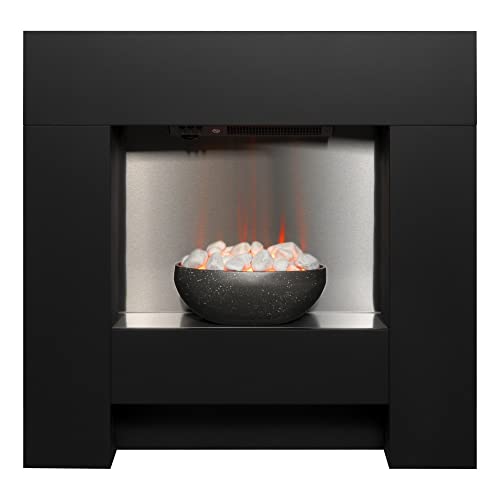The Top Fireplace Gurus Are Doing 3 Things

The Fireplace: A Warm Embrace of Tradition and Comfort
Fireplaces have been an important part of human habitation for centuries, working as a source of warmth, a gathering place, and a sign of convenience. While the modern versions might vary incredibly from their ancient forefathers, the appeal of a fireplace endures. This post checks out the numerous elements of fireplaces, including their history, function, types, and upkeep, while also dealing with regularly asked concerns.
The Evolution of Fireplaces
Fireplaces go back to ancient times when open flames were utilized for cooking, heating, and defense from wildlife. Over the centuries, fireplaces evolved from simple fire pits to the sophisticated renditions we see today. Here is a short timeline of their evolution:
- Prehistoric Era: Cavemen utilized open flames for warmth and cooking. Wind and smoke often blew into residences.
- Middle Ages: Stone and brick fireplaces ended up being common in homes and castles, including chimneys to bring smoke outside.
- Renaissance: Elaborately designed mantels emerged, and fireplaces ended up being centers of social interaction.
- Industrial Revolution: Innovations in heating materials caused a variety of designs and performances.
- Modern Era: The arrival of natural gas, electric, and bioethanol fireplaces provided cleaner options to traditional wood-burning systems.
Table 1: The Evolution of Fireplaces
| Period | Attributes |
|---|---|
| Ancient Era | Open flames for warmth and cooking |
| Middle Ages | Stone and brick structures with early chimneys |
| Renaissance | Elaborate mantels, social centers |
| Industrial Revolution | Diverse designs, introduction of brand-new materials |
| Modern Era | Gas, electric, and bioethanol alternatives |
The Purpose of a Fireplace
Fireplaces serve dual purposes: they offer physical heat and develop a psychological environment. Homeowners frequently gather around the fireplace to bond, share stories, and delight in a cozy setting. The glow of a fire can be calming, adding to a sense of relaxation and intimacy. Beyond personal enjoyment, fireplaces also offer practical benefits, consisting of:
- Home Heating: Effective heat source, particularly in chillier climates.
- Increased Home Value: A well-designed fireplace can enhance the aesthetic worth of a home.
- Emergency situation Heating: In case of power interruptions, wood-burning fireplaces can work as a crucial heat source.
- Visual Appeal: A centerpiece that adds to interior decoration.
Types of Fireplaces
Today, fireplaces come in numerous styles and fuel types, accommodating a diverse range of choices and settings. Here are some typical types:
Wood-Burning Fireplaces:
- Traditional fire pits
- Traditional masonry fireplaces
- Require significant maintenance and chimney upkeep
Gas Fireplaces:
- Available in both direct vent and ventless varieties
- Simpler to utilize and preserve than wood-burning fireplaces
- Supply instantaneous heat with a flick of a switch
Electric Fireplaces:
- Offer associated heat sources without real flames
- Often designed to simulate traditional fireplaces
- Perfect for smaller sized spaces and homes without a chimney
Bioethanol Fireplaces:
- Use bioethanol fuel, providing a sustainable option
- Need no ventilation and can be placed anywhere
- Safe and easy to keep
Table 2: Types of Fireplaces
| Type | Fuel Source | Functions | Maintenance Requirements |
|---|---|---|---|
| Wood-Burning | Wood | High ambiance, heat source | Regular chimney cleaning |
| Gas | Gas or gas | Instantaneous heat | Very little, occasional servicing |
| Electric | Electrical energy | Easy setup | Extremely low upkeep |
| Bioethanol | Bioethanol fuel | Ventless, portable | Low, mainly cleaning up |
Maintenance and Safety Considerations
Owning a fireplace includes certain obligations, specifically concerning its safe operation and long-term upkeep. Here are essential maintenance ideas and security standards:
Maintenance Tips:
- Annual Inspection: Always have your chimney and fireplace inspected a minimum of once a year by a qualified specialist.
- Routine Cleaning: Clean out ashes and particles after each use, and make sure the flue is open before starting a fire.
- Look for Cracks: Inspect masonry for fractures or damage to prevent structural concerns.
- Usage Proper Fuel: Only usage dry, seasoned wood for wood-burning fireplaces; do not burn cured wood.
Security Guidelines:
- Install Smoke Detectors: Ensure smoke detectors are functional, evaluating them monthly and changing batteries as needed.
- Keep a Fire Extinguisher: Have one nearby, even if a fireplace is utilized rarely.
- Monitor Flames: Never leave a fire ignored, and make sure kids and animals are monitored around the fireplace.
Frequently Asked Questions (FAQs)
1. How can I decrease smoke from a wood-burning fireplace?
To decrease smoke, usage dry, seasoned wood, and guarantee that your chimney is clean and unblocked.
2. Is it safe to use gas fireplaces throughout a gas leak?
Never use a gas fireplace during a gas leakage. Instantly evacuate the area and contact gas services for help.
3. Can I set up an electric fireplace myself?
Electric fireplaces are generally simple to set up, but it is recommended to talk to professionals to make sure security and compliance with regional building regulations.
4. What is sneak a peek at these guys of fireplace for small areas?
Electric fireplaces or bioethanol designs are often best for small spaces, as they do not need substantial ventilation or structural adjustments.
Fireplaces have transcended their initial purpose of supplying heat to become valued components of home design and family life. They stimulate memories of heat, celebrations, and togetherness while offering practical advantages that boost modern living. By understanding the various kinds of fireplaces, their maintenance, and security practices, house owners can delight in the classic appeal of this precious feature for generations to come.

